As an Amazon Associate, I earn from qualifying purchases.
An easy step-by-step tutorial on Canning Applesauce. This recipe for how to preserve apples is perfect for beginners and experienced canners alike. Instructions include low-sugar and no-sugar options.
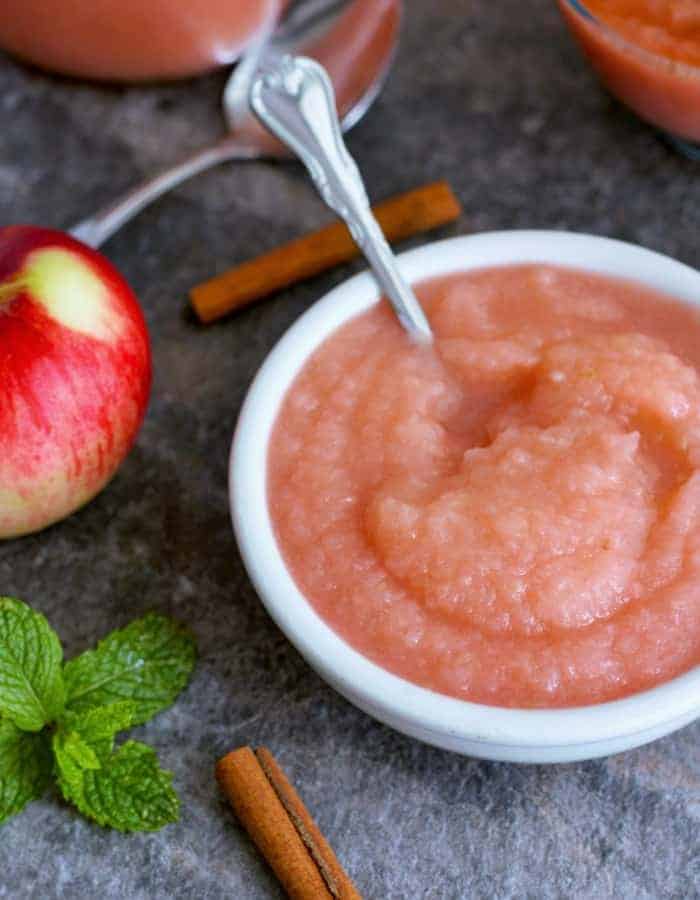
If you’ve never canned applesauce before, it can seem overwhelming and a lot to take in. Don’t be intimidated; I’m here to help. We’re in this together!
While canning can be hard work, when I open up a fresh jar from canning peaches, canning tomato soup, canning whole tomatoes, canning pears, or applesauce in the middle of winter, it is always worth the effort.
If you have leftover apples when you’re done with this easy applesauce recipe, you’ll love canning apple butter, freezing apples, making cinnamon apples, or Healthy Apple Nachos.
Even better, you can use some of your homemade applesauce for whipping up a batch of Cinnamon Apple Donuts!
CANNING EQUIPMENT LIST
Check out this in-depth post for a complete list of canning supplies.
- Apples! You’ll need about 21 lbs per 7 quarts.
- At least two large bowls. You can never have enough bowls when canning.
- Large pot of water for parboiling the apples and another to keep the finished sauce warm before canning OR use a slow cooker to free up space on your stove.
- Food mill (optional) but super helpful when canning a lot of apples at once. See notes in the post if you don’t have a food mill.
- Canner: simple water bath canner, a pressure canner (which can double as a water bath canner), or even a huge stockpot with a rack in the bottom.
- Canning tongs/jar lifter
- Jars – quarts or pints.
- New canning lids
- Canning rings for the jars
- Wide mouth funnel
- Cutting board
- Slotted spoon
- Strainer/colander
- Chef’s knife
- Ladle
- Butter knife or plastic chopstick
- Comfortable shoes. Don’t do this barefoot. Your back will hate you.
- Clean washcloths and at least one large thick clean towel.
How to Can Applesauce
*I’ll walk you through it here with some photos and tips, and you’ll also find a printable recipe card at the bottom of the post with exact measurements, etc. You can also click “jump to recipe” to skip down.
Canning applesauce is broken down into three main steps:
- Canning prep
- Making applesauce
- Canning the applesauce
Canning Prep
Prepare your water bath canner by filling it with water. You just need to have enough water to cover the jars by 1 inch once the water is boiling.
Set the canner on the stove. Turn the burner to high. Once it reaches a boil, reduce it to a simmer. You want to keep the water hot so that everything is ready when the applesauce is.
Wash and clean your jars. You’ll want to keep the jars warm enough to avoid having them crack when placed in the canner. You can fill them with hot water, or place them on a tray in the oven at 170˚F.
Wash your lids and set them aside in a clean place. You no longer need to simmer lids in water to keep them sterile. Woot!
Making Applesauce
Set a medium/large pot of water to medium-high on your stove.
Wash your apples and cut into eighths, or more if you have particularly large apples. Add apples to the hot water and cook until they have softened (~1-5 minutes depending on your type of apple).
Remove using a slotted spoon and place in a strainer set into a large bowl.
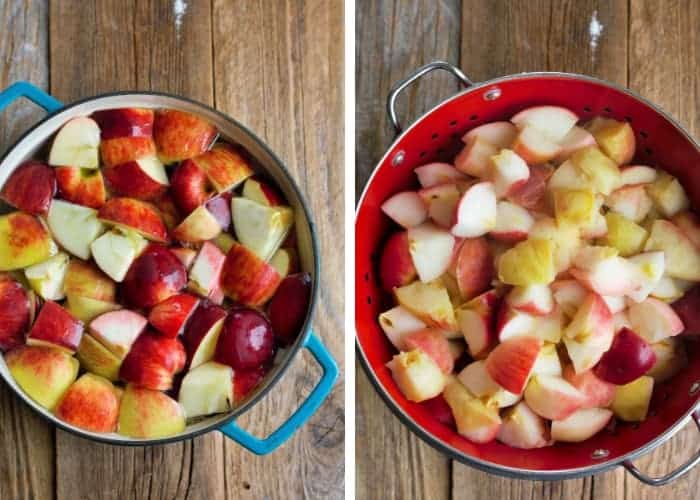
Run the apples through a food mill to remove the seeds and skins. Pro tip: For safety purposes, you need to keep the sauce warm until you have enough to can. I use my slow cooker set to warm for this because it frees up space on my stove for the other steps in the canning process.
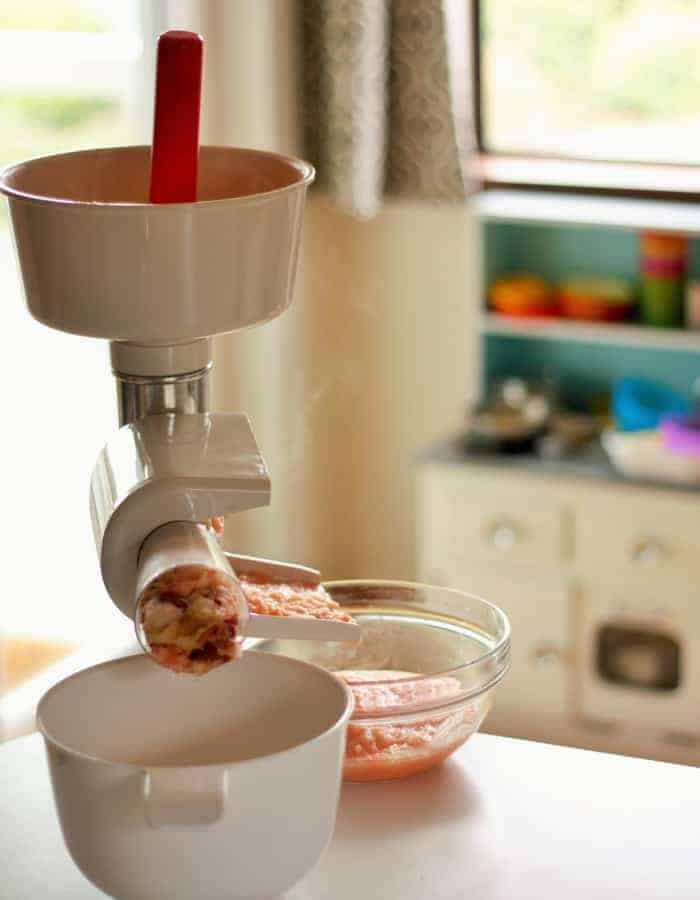
Return the burner to high and bring the water in the canner back to a rapid boil.
Using a canning funnel, ladle the warm applesauce into jars, leaving 1/2 inch of headspace. Remove any bubbles from the jar (I use a plastic chopstick).
Use a wet clean rag and wipe the rim of the jars to make sure it is free of any food.
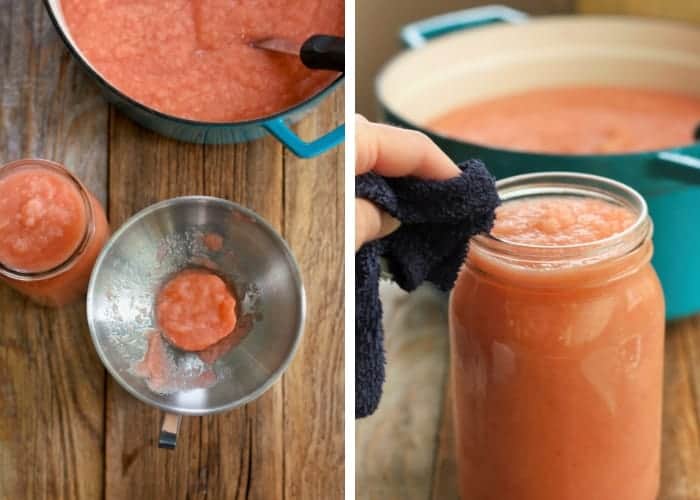
Place a clean lid on the jar. Add a ring, and tighten to fingertip tight.
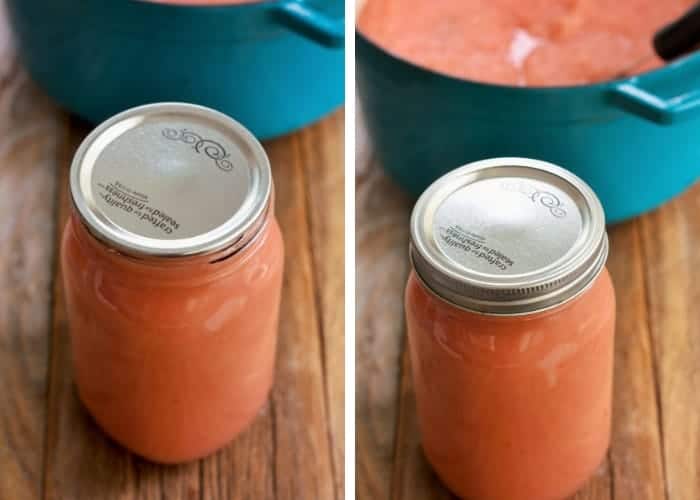
Using canning tongs, carefully place your jars in the canner. Put the lid on. Processing times will vary based on altitude. See the chart below. Pro tip: the water must return to a boil in the canner before you can start the timer.
Processing Time for Applesauce
| Processing Time for Applesauce | |||||
| Process Times at Altitudes of: | |||||
| Style of Pack | Jar Size | 0-1,000 ft | 1,001-3,000 ft | 3,001-6,000 ft | Aove 6,000 ft |
| Hot | Pints | 15 min | 20 min | 20 min | 25 min |
| Quarts | 20 min | 25 min | 30 min | 35 min | |
| *Source: National Center For Home Food Preservation | |||||
Once the jars have been processed for the appropriate amount of time, remove the canner from the burner, wearing oven mitts carefully take off the lid of the canner, and allow it to sit for 5 minutes. Pro tip: I tend to just slide the canner into the middle of my stove, as it weighs a ton.
Carefully remove the jars with canning tongs, and place them on a thick towel in a place where they can be undisturbed for 12 hours.
The lids will likely start to pop within 20-30 minutes of being removed from the water. That popping sound is music to your ears, as it tells you that everything has been sealed. It’s a reward for all your work!
After the jars have rested for about 12 hours, press down in the middle of each lid. If it “gives” at all, the jar didn’t seal. Either enjoy it that day, put it in the fridge, or reprocess it with a new lid.
Pressure Canning Applesauce
If you prefer to pressure can your applesauce, follow the prep and packing process above and the canning process below.
Add 3 quarts of water to your pressure canner and put it on a burner set to high. Make sure there is a canning rack in the bottom of the canner.
Using canning tongs, gently place the jars in the canner. Lock the lid. Soon, steam will start coming through the vent pipe (I call it the steam chimney).
Allow the steam to pass through for about 10 minutes. Then put the pressure regulator (I call it the chimney cap) on top. (see the 4 photo grid below for a visual of this process step by step)
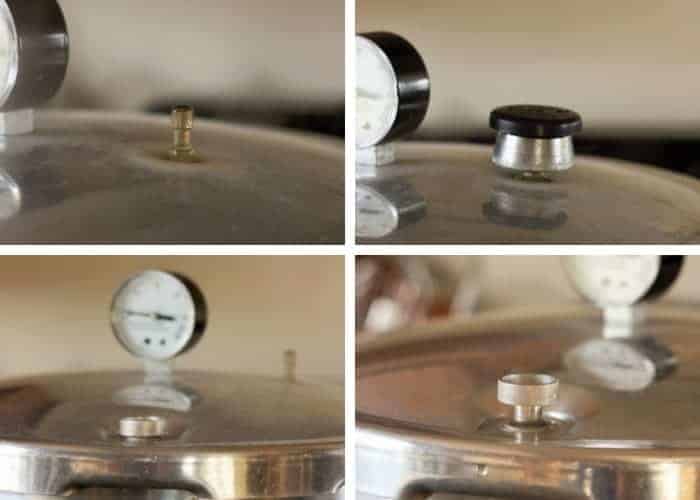
Pretty soon, the air vent will pop up. That is a sign that you’re starting to build pressure inside the canner (get excited. This is happening!). Processing times will vary based on altitude. See the charts below.
Pressure Canning Applesauce in a Dial-Gauge Pressure Canner
| Canner Pressure (PSI) at Altitudes of | ||||||
| Style of Pack | Jar Size | Processing Time | 0-2,000 ft | 2,001-4,000 ft | 4,001-6,000 ft | 6,001-8,000 ft |
| Hot or Raw | Pints | 8 mins | 6 lbs | 7 lbs | 8 lbs | 9 lbs |
| Quarts | 10 mins | 6 lbs | 7 lbs | 8 lbs | 9 lbs | |
| *Source: National Center For Home Food Preservation | ||||||
Processing Time for Applesauce in a Weighted-Gauge Pressure Canner
| Canner Pressure (PSI) at Altitudes of: | ||||
| Style of Pack | Jar Size | Processing Time | 0-1,000 ft | Above 1,001 ft |
| Hot | Pints | 8 mins | 5 lb | 10 lb |
| Quarts | 10 mins | 5 lb | 10 lb | |
| *Source: National Center For Home Food Preservation | ||||
When the dial gauge reaches the appropriate PSI, reduce the burner temp to medium, and start your timer. The pressure must stay at the PSA or (a little bit) above for the duration of the cooking time. You’ll likely need to adjust the temp on the burner a few times depending on your stove.
When the time is up, remove the canner from the burner and allow it to sit until you hear a distinctive “click” of the air vent dropping. Remove the pressure regulator and carefully remove the lid of the canner (Pro tip: I always use oven mitts when I take the lid off because the steam is super hot).
Let the jars sit for 5 minutes in the canner with the canner lid off and then lift them out with canning tongs. Pro tip: allowing the jars to sit in the canner with the canner lid off can help reduce the siphoning of sauce out of your jars.
Place hot jars on a towel where they can sit undisturbed for 12 hours.
After a few hours, to check for sealing, gently press down in the middle of the lid. If the lid has no give, it’s sealed. If you can press the lid in and it pops a bit, your jars are not sealed.
Storage for Home Canned Applesauce
Once the jars have sealed, remove the rings. Label and store sealed jars in a cool (best results are 50-70˚F) dark place for up to 12-18 months.
If you have the space available, do not stack the jars on top of each other more than two jars high.
Which Apples Do You Use For Homemade Applesauce?
Most varieties typically work fine, but you’ll have the best results with any apple labeled as “saucing apples“. Easy-to-find varieties such as Gala, Fuji, Braeburn, and Cameo would all be great. Avoid anything in the “juicing” category.
Tart or sour apples like Granny Smith will likely be too watery and mouth-puckering to be a good choice. Have tart apples? Mix one pound of tart for every two to three pounds of sweet apples for a balanced sauce. You can also can Apple Pie Filling with tart apples since there is some sugar added.
We have access to a local self-serve apple farm (this is Washington State after all!) and I love doing a mix and match of different kinds for homemade applesauce. The pretty pink sauce in these photos is a mix of Burgandy, Akane, and Jonagold, with the lovely rose hue coming mainly from the Burgandy.
How Long Do You Water Bath Can Applesauce?
The Ball Blue Book Guide to Preserving calls for water bath canning applesauce for a minimum of 15 minutes for pints and 20 minutes for quarts. Some adjustments will need to be made based on altitude. See the altitude guide above and in the printable recipe card.
How to Sweeten Applesauce
Apples have enough natural sugar to be safely canned without any added sweeteners.
Canning no sugar-added applesauce gives you more flexibility to use at a later time. You can always sweeten individual servings to taste once the jar is opened.
But if you would like to sweeten your canned applesauce, you can add sugar, honey, or even maple syrup. Start with a small amount (like 1/4 cup) and slowly add more to taste. And feel free to add cinnamon, nutmeg, or cloves.
Do You have to add lemon juice when canning applesauce?
Nope! Lemon juice is needed when the produce that you’re canning doesn’t contain enough natural sugar or has a natural level of acid that is not consistent enough to be considered safe (like tomatoes).
Apples are naturally sweet and can be canned with or without added sugar or lemon juice. However, I do recommend combining lemon juice or citric acid with water in a large bowl for canning prep. I place the cut apples into the lemon juice water to prevent browning before parboiling them.
How to Can Applesauce Without a Food Mill
The recipe below calls for using a food mill to process the applesauce, but there are workarounds for this if you don’t own a food mill.
Peel apples and cut them into eights, removing the seeds and core. You can make applesauce in an Instant Pot (Manual>high pressure>5 minutes>natural release) or in the slow cooker (cook all day on low without any additional liquid added), and then blend, blend, blend!
Alternatively, you can cook the apples down on low heat in a large pot on the stove. Cook and stir often and blend to your desired consistency.
You don’t have to remove the skin if you’d like to skip the peeling step, but there is more of a chance of contamination when canning if the skins are left on.
HELP! WHY Are My Jars Leaking Juice/Sauce?
If you find that juice has leaked out after they have sealed, you have experienced a common canning issue called siphoning. It happens to the best of us!
Siphoning is typically caused by not allowing the jars to rest in the canner after they have finished processing. In the directions above, you’ll see that I recommend you remove the canner from the burner, remove the lid, and let it sit for 5 minutes.
This is important as it allows the jars time to rest before being allowed to cool on the counter. Doing this process will significantly cut down on siphoning.
IF YOU HAVE SIPHONING IN YOUR JARS, FOLLOW THESE STEPS:
- Check – are the lids still sealed?
- Look – have you lost less than half of the amount of liquid in the jar?
- Examine – does the fruit look fresh with bright colors?
If the answer to the above three steps is “yes!”, then they are safe to eat.
Another common reason for siphoning is not leaving enough headspace in the jar. You need to keep 1/2 of space between the top of the food and the top of the jar to allow for the sauce to expand while it is in the canner.
WHAT IF MY JARS DON’T SEAL?
If you’ve correctly processed your homemade applesauce, and the lids still didn’t seal, you can reprocess them.
Double-check to make sure there are no:
- Chips in the rim of the jar
- Dried juice or bits of applesauce on the rim (anything between the rim and the lid may prevent a seal.
Best practices would involve using brand new lids for reprocessing. Set aside the old lids to use for dry storage (related: Pantry Essentials for the Home Cook).
If the jars don’t seal on the second attempt, you likely have a bad batch of lids, or your canning process has a step missing. Email me and we’ll try to troubleshoot what is going on.
For unsealed jars, you can place them in the fridge. Eat the applesauce within three weeks.
Freezing Applesauce
Your homemade applesauce can be frozen in wide-mouth canning jars. Leave 1 inch of headspace in the jars to allow for expansion during freezing. Allow the sauce to fully cool in the jar before freezing.
Pro Tips/Recipe Notes
- You’ll need about 21 pounds of apples to fill seven quarts, and 13 pounds to fill nine pints. A bushel of apples weighs 48 pounds and will yield 14-19 quarts. You don’t have to can that many pounds at once, but you should have at least two jars in the canner at once while processing.
- If you don’t have enough jars to fill the canner, consider Canning Water in a few jars to stock your emergency drinking water supplies.
- Your applesauce may separate in the jars after canning. This is totally safe as long as the jars are sealed. This is the result of using apples with higher juice content.
- Stir in some homemade Strawberry Puree into individual bowls prior to serving for a delicious apple/strawberry sauce.
More Recipes Like This
- Complete Guide to What to Can in Fall
- Canning Apricots
- How to Can Potatoes
- Low-Sugar Strawberry Jam
- How to Make Dried Apples
- Blackberry Syrup
- Strawberry Freezer Jam Recipe
- How to Can Corn
- Peach Compote
- Canning Cranberry Sauce
- Homemade Strawberry Syrup
- How to Can Green Beans
- Refrigerator Dilly Beans
- Cinnamon Pretzel Bites With Apple Syrup
- Check out all my canning recipes!
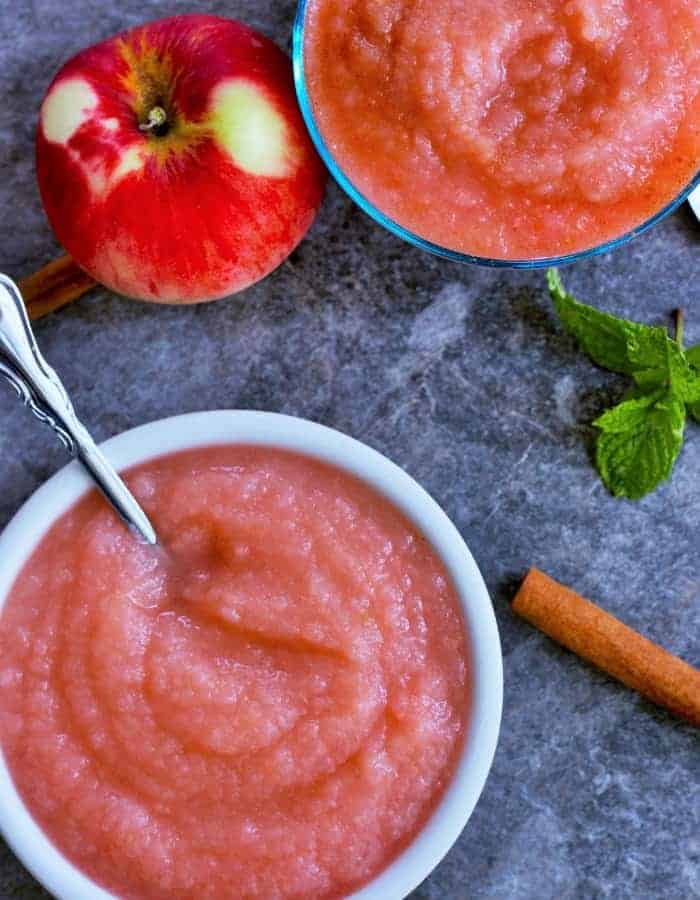
Canning Applesauce {Preserving Apples}
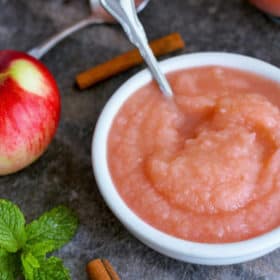
Equipment
Instructions
CANNING PREP
- Prepare your water bath canner by filling it with water. You just need to have enough water to cover the jars by 2 inches once the water is boiling.
- Set the canner on the stove. Turn the burner to high. Once it reaches a boil, reduce it to simmer. You want to keep the water hot so that everything is ready when the applesauce is.
- Wash and sanitize your jars. You’ll want to keep them warm to avoid having them crack when placed in the canner. You can fill them with hot water, or place them on a tray in the oven at 170˚F.
- Wash your lids and set aside in clean place. You no longer need to simmer lids in water to keep them sterile.
Prep the Apples/Sauce
- Set a medium/large pot of water to medium high on your stove.
- Wash your apples and cut into eighths, or more if you have particularly large apples.21 pounds apples
- Pro tip: if you are cutting a lot of apples at once, consider filling a bowl with cool water and 1/4 cup of lemon juice to prevent browning.
- Add apples to the hot water and cook until they have softened (~1-5 minutes depending on your type of apple).
- Remove using a slotted spoon and place in a strainer set into a large bowl.
- Run the apples through a food mill to remove the seeds and skins. Keep warm until ready to can (I use my slow cooker set to warm).
- Return the burner to high and bring the water in the canner back to a rapid boil.
- Using a canning funnel, ladle in the warm applesauce into jars, leaving 1/2 inch of headspace. Remove any bubbles from the jar (I use a plastic chopstick).
- Use a wet clean rag and wipe the rim of the jars to make sure it is free of any food.
- Place a clean lid on the jar. Add a ring, and tighten to fingertip tight.
Canning the Applesauce
- Lower your jars into the canner using canning tongs/jar lifter.
- Process pints and quarts based on the elevation guide below:*0-1,000 ft – Pints =15 min Quarts =20 min*1,001-3,000 ft – Pints =20 min Quarts =25 min*3,001-6,000 ft – Pints =20 min Quarts =30 min*6,000 ft+ – Pints =25 min Quarts =35 min
- Once the jars have processed for the appropriate amount of time, remove the canner from the burner, and carefully remove the lid of the canner (Pro tip: use oven mitts to take the lid off because the steam is super hot).
- Using canning tongs, carefully remove the jars, and place them on a thick towel in a place where they can be undisturbed for 12 hours.
- After the jars have rested for about 12 hours, press down in the middle of each lid. If it "gives" at all, the jar didn't seal. Either enjoy it that day, put it in the fridge, or reprocess it.
Notes
- You’ll need about 21 pounds of apples to fill seven quarts, and 13 pounds to fill nine pints. A bushel of apples weighs 48 pounds and will yield 14-19 quarts.
- This applesauce can be frozen in wide-mouth canning jars. Leave 1 inch of headspace in the jars to allow for expansion during freezing. Allow to fully cool in the jar before freezing.
- Your applesauce may separate in the jars after canning. This is totally safe as long as the jars are sealed. This is the result of using apples with higher water (juice) content.
- Once the jars have sealed, remove the rings. Label and store sealed jars in a cool (best results are 50-70˚F) dark place for up to 12-18 months.
Nutrition
Nutrition information is automatically calculated, so should only be used as an approximation.

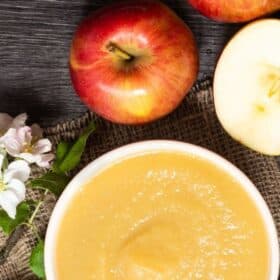
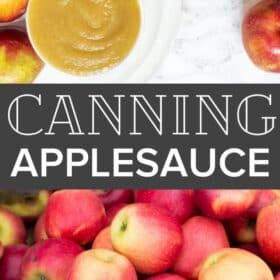
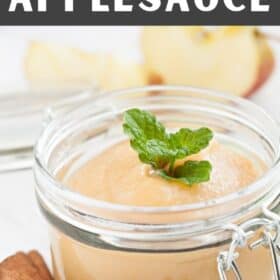
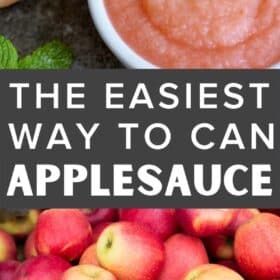
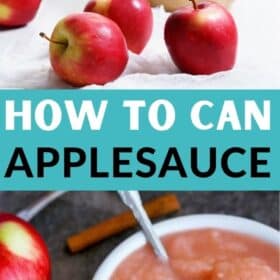
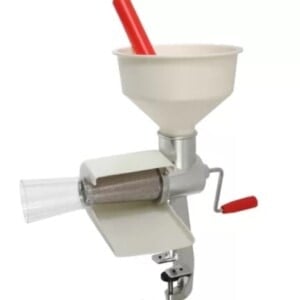
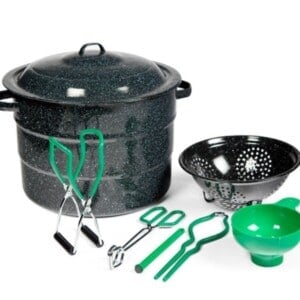
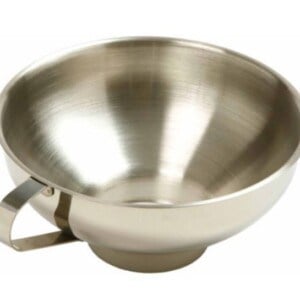

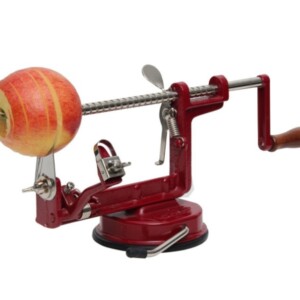
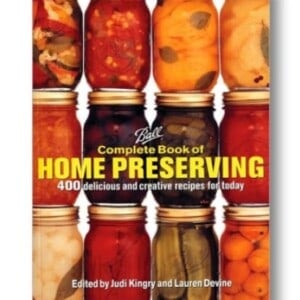

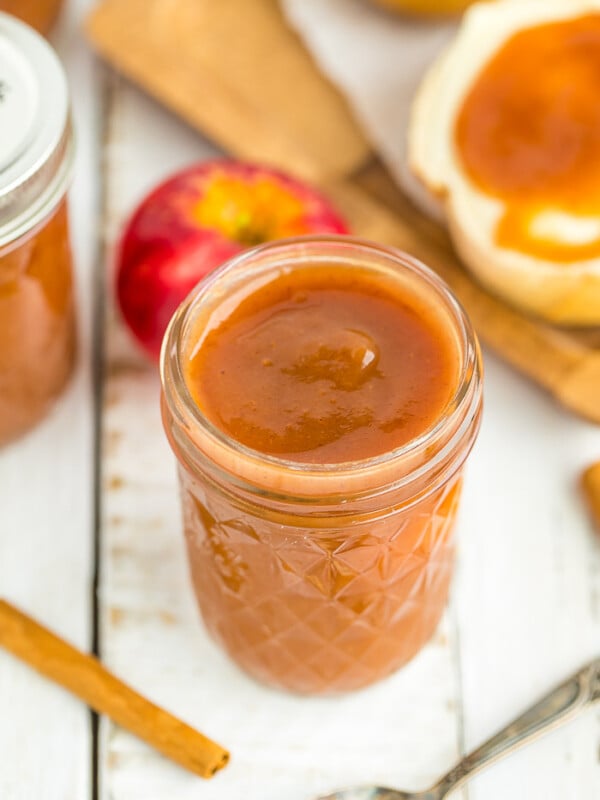
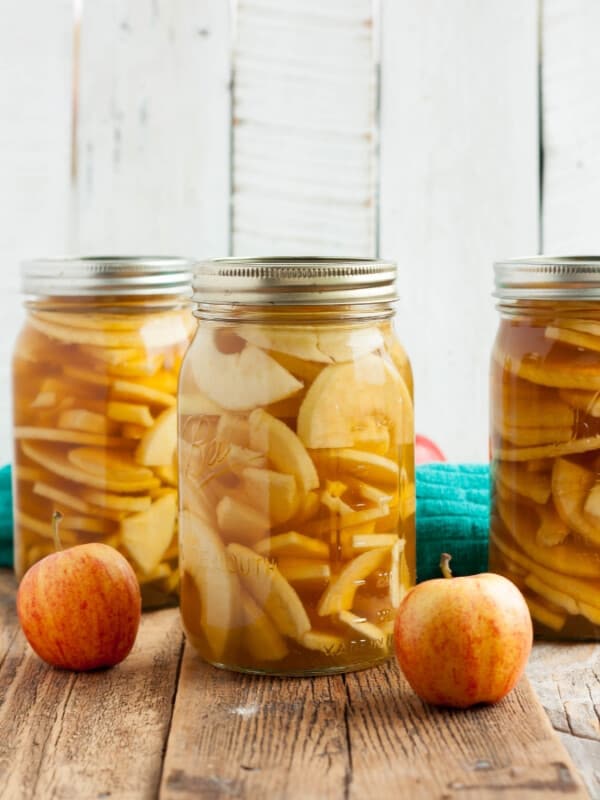
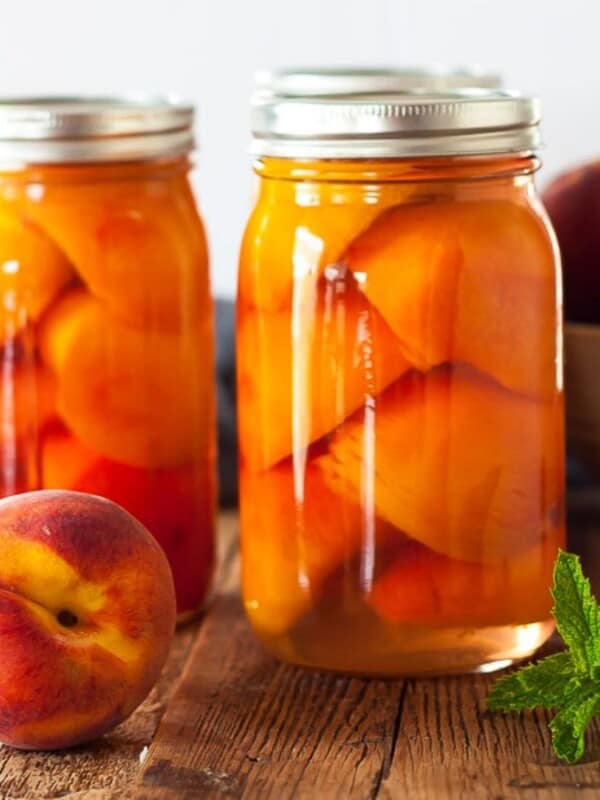
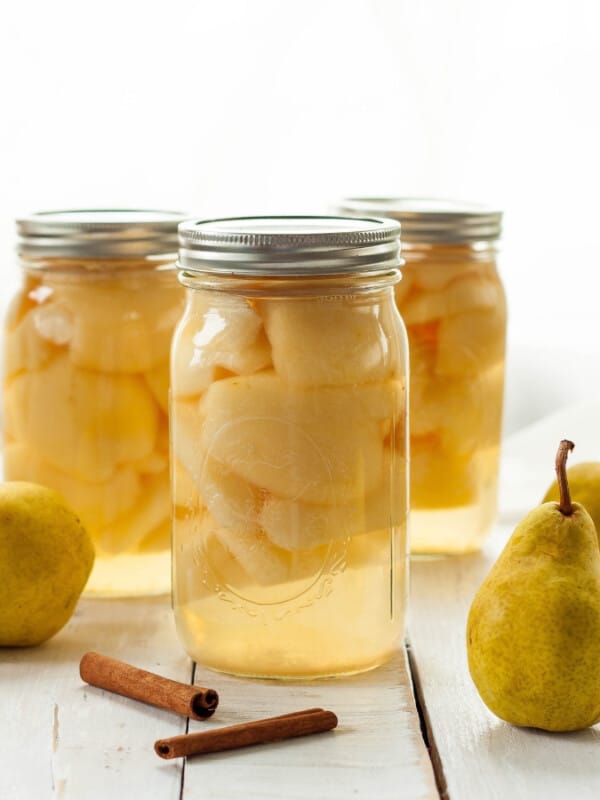
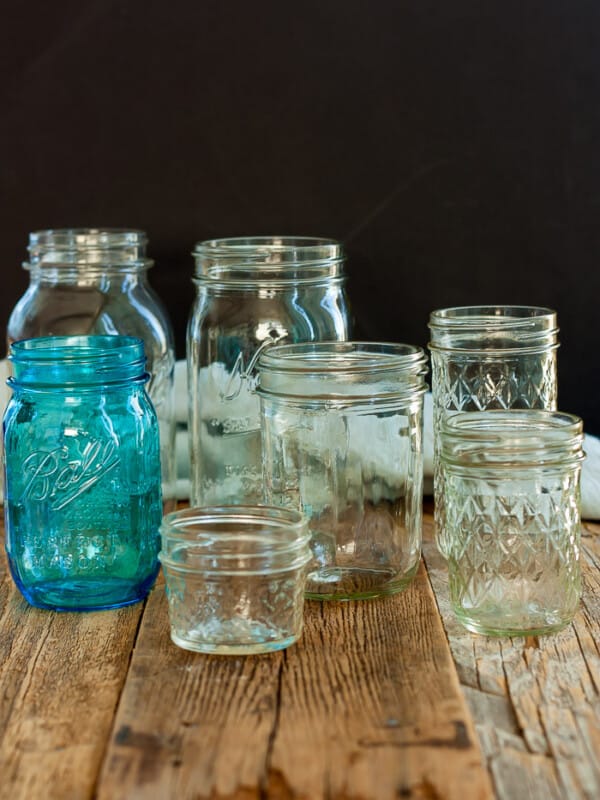
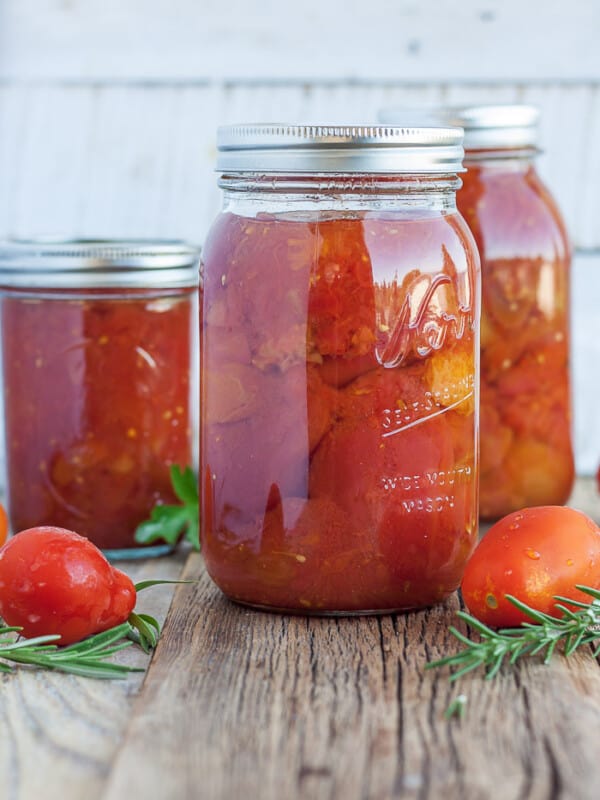






I canned the applesauce per your recipe. Checked the lids which didn’t give when pressed. However, the ring on it was a little loose. I guess, I had them only finger tight. Is it still safe to store and eat later?
Hi SA, you should be absolutely fine!
The rings are there to keep the lids in place during the canning process.They’re not needed to keep the lids on there once sealed. Many canners choose to keep the rings off for long-term storage.
Hi Sarah,
Just wanted to say hi! Ive been using your blog quite a bit the last few months. I found it when my husband and I did another round of Whole30 in June and I needed some fresh inspo. Now I find myself coming back for all the canning recipes. I taught myself how to can last year and I’m working hard now to set aside some goodies for the winter. Last week I canned beets following your instructions. This week, I have a 20lb box of Gravenstein apples to preserve. I’m currently canning my favorite applesauce recipe from Danielle Walker that involves an instant pot for prep and I’m following your directions for safe canning. Next up is your low sugar apple butter! Can’t wait to try. Anyway, thank you for sharing all your hard work on this blog. I love it!
Christina (a fellow Seattleite)
Christina, it’s lovely to hear from you and amazing work on the canning! It can be such an intimidating process, but good on you for jumping in. I’m honored I have been a part of it in any way.
Apple butter is one of those recipes where your house is going to smell so amazing. Enjoy it!
Just found your site and am loving it so far, keep up the good work.
Youre so cool! I dont suppose Ive read something like this before.
They are hard to find, but THE BEST apples (in our family’s opinion) are Gravenstein. They have just enough tartness and moisture to make fantastic applesauce and apple butter.
Maybe it’s because I’m in Washington, but Gravensteins are pretty easy to find here. And I agree with you that they’re delicious!!
I don’t have a food mill… Typically when I’m making fresh applesauce, I core and peel the apples before cooking then run them through the blender. Will this still work?
Yes, that still works! The food mill is just one of many methods for making applesauce.